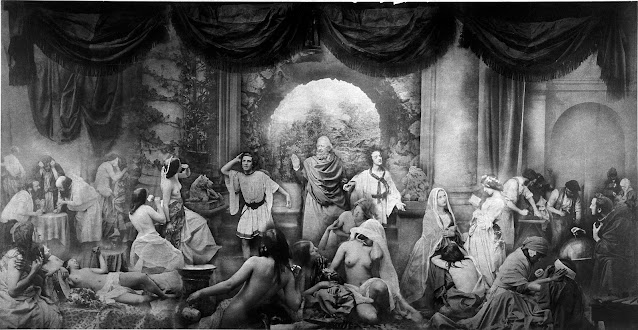Hippolyte Bayard (1801 – 1887) was a French photographer and pioneer in the history of photography.
- Bayard invented his own process that produced direct positive paper prints in the camera and presented the world's first public exhibition of photographs on 24 June 1839.
- He claimed to have invented photography earlier than Louis-Jacques Mandé Daguerre in France and William Henry Fox Talbot in England, the men traditionally credited with its invention. He was embittered at being deprived of what he saw as his rightful due and recognition.
- Bayard experimented with the new medium taking photos of plant specimens, statuary (including posing with them for self-portraits), street scenes, urban landscapes, architectural photos, and portraits. He photographed prominent figures and an ordinary worker. He also advocated combination printing and was one of the founders of a photo society.
Self portrait (1847)
Hoax Photograph:
- Bayard was persuaded in 1839 to postpone announcing his photographic process to the French Academy of Sciences by François Arago, a friend of Louis Daguerre, who invented the rival daguerreotype process. Arago's conflict of interest cost Bayard his recognition as one of the principal inventors of photography. He eventually gave details of the process to the French Academy of Sciences on 24 February 1840, in return for money to buy better equipment.
Photography pioneers Hippolyte Bayard (left) and Louis Daguerre (right)
- To protest the injustice of Arago’s conflict of interest, Bayard went and created the first hoax photo. It was titled “Self Portrait as a Drowned Man,” and was meant to make people believe that he had committed suicide.
- On the back of the photo was this statement:
The corpse which you see here is that of M. Bayard, inventor of the process that has just been shown to you. As far as I know this indefatigable experimenter has been occupied for about three years with his discovery. The Government, which has been only too generous to Monsieur Daguerre, has said it can do nothing for Monsieur Bayard, and the poor wretch has drowned himself. Oh the vagaries of human life....! ... He has been at the morgue for several days, and no-one has recognized or claimed him. Ladies and gentlemen, you'd better pass along for fear of offending your sense of smell, for as you can observe, the face and hands of the gentleman are beginning to decay.
Later life:
- Luckily for photography, Bayard didn’t kill himself.
- He would go on to contribute a good deal to the young medium over the remaining 50 years of his life. He helped found the French Society of Photography, and invented what became known as combination printing, the technique of using the negatives of two or more images in conjunction with one another to create a single image.
Some examples of early combination printing from other photographers:
Oscar Gustave Rejlander's Two Ways of Life, 1857
One of the earliest and most famous combination prints is Oscar Rejlander's Two Ways of Life. The print was created in 1857. It was first exhibited at the Manchester Art Treasures Exhibition and it is considered one of the most distinguished examples of the technique. It used a combination of 32 negatives to create the complete image of the final product. The process took about six weeks.
Henry Peach Robinson's When the Day's Work is Done, 1877. A combination print made from six different negatives.
Henry Peach Robinson's Fading Away, 1858
Sometimes called Robinson's "masterpiece," his photograph, Fading Away, was a combination print that he generated in 1858. It took him around five negatives to create the final image. The photo shows a death of a young girl and her grieving family surrounding her. The subject was made up by Robinson and the figures were only posing, but the scene with the girl being centred and bright and the figure turned away, behind in the darkness, created an emotional exhibit.










No comments:
Post a Comment
Note: Only a member of this blog may post a comment.